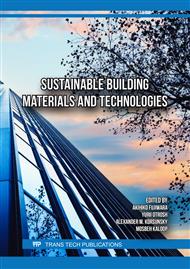p.25
p.33
p.45
p.53
p.61
p.67
p.75
p.83
p.93
Low-Temperature Mixed Mode (I/II) Fracture Characterization of Polymerized Sulfur Modified AC Mixtures
Abstract:
In this study, asphalt concrete (AC) mixtures were modified with polymerized sulfur, using PG58-22 bitumen, and crushed siliceous aggregate. Modifications involved replacing the base binder with 20%, 30%, and 50% polymerized sulfur, compared to a control mix with no replacement. The mixtures were subjected to Single Edge Notched-Beam (SE(B)) fracture tests under mixed mode (I/II) conditions with notch offset value of 48 mm, with temperatures ranging from 0 °C to -20 °C. These tests, focusing on the mixtures' response to mixed mode loading, provided load-displacement curves, enabling the determination of fracture energy. Results indicated an increase in fracture energy for 20% and 30% sulfur-modified mixtures. However, a trend towards increased embrittlement was also observed, as fractures occurred at lower displacements. Significantly, higher sulfur content correlated with similar or decreased mixed-mode (I/II) fracture energy, suggesting an improved resistance to low-temperature cracking for lower replacement percentages.
Info:
Periodical:
Pages:
61-66
Citation:
Online since:
August 2024
Authors:
Price:
Сopyright:
© 2024 Trans Tech Publications Ltd. All Rights Reserved
Share:
Citation:


